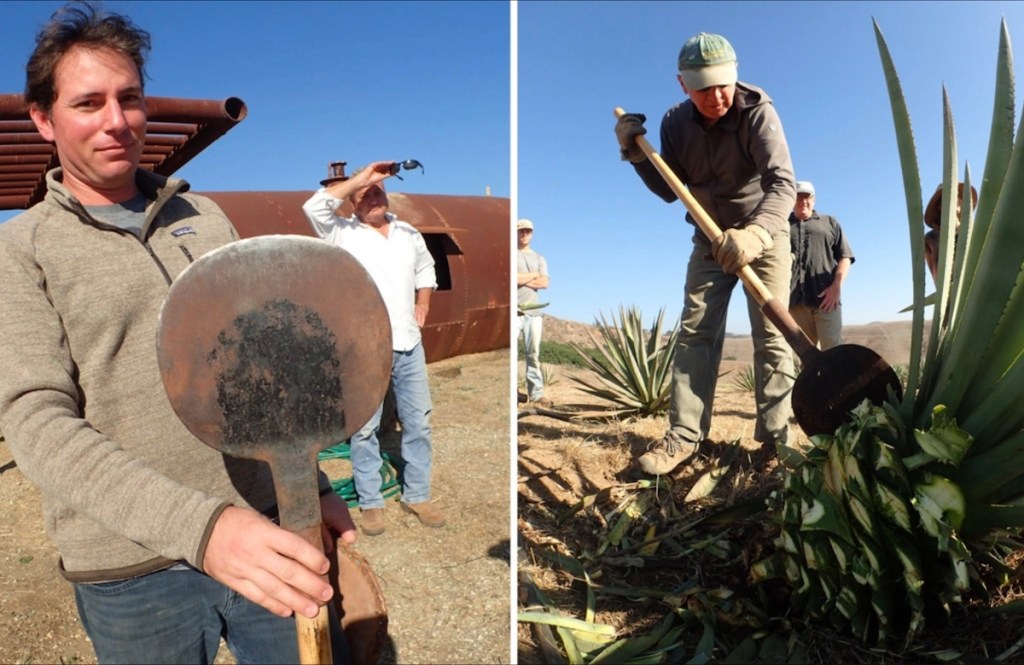In 2019, I wrote a cover story about how La Paloma Ranch along the Gaviota Coast was growing agave in order to turn the drought-tolerant, firebreak-ready plant into booze. I was able to participate in one of their first harvests, and even delivered one of the plucked piñas down to Ventura Spirits, which was turning the crop into an agave spirit. (I also wrote about those results here.)
There’s been a smattering of news since then that I see on occasion, particularly in parts of Northern California, where Craig Reynolds is considered a sort of godfather in this movement toward a truly domestic agave spirit industry. “It’s been pretty exciting,” said Reynolds to me on the phone this week. “Many more people are now putting agave in the ground throughout the state.” They’re typically buying plants straight from Reynolds or from Doug Richardson of Drylands Farming Company in Carpinteria.
Recently, Reynolds’s own agaves of the tequilana variety were turned into liquor by Venus Spirits in Santa Cruz, Ventura Spirits, and Shelter Distilling in Mammoth Lakes. And there’s another release expected soon from Jano Spirits in Napa County, which made a batch from the americana agave variety grown by Reynolds’s neighbor.
These batches are small, usually between just 250-450 bottles, but they sell out quickly, typically straight through the distilleries’ tasting rooms and websites. The hope is that these direct sales will help distilleries invest further in the specialized equipment needed for processing agave, which is more challenging that the typical fruits and grains used in distillation.
Reynolds is also leading the way on agave’s organizational and legislative fronts. Less than two months ago, he spearheaded the creation of the California Agave Council, a nonprofit trade group with lobbying power that includes about 10 distillers and two dozen growers. Right now, the council is shepherding a piece of legislation through Sacramento that will establish a statewide standard for anything that’s labeled “California agave spirit.”
“It must be 100 percent California-grown, without flavor or coloring additives,” said Reynolds. “Those have become a consumer concern because tequila is allowed to use additives without disclosure.”
In fact, anything federally recognized by the American government’s Tax & Trade Bureau (TTB) as tequila (which can only come from Mexico) or an agave spirit is allowed to have a wide array of additives, including up to 49 percent of a different sugar base. So that tequila or agave spirit in your cabinet may actually be only 51 percent distilled from agave, with another 49 percent coming from sugar cane or corn sugar.
“There’s nothing wrong about that, other than that people in some cases are not aware that’s the case,” said Reynolds, who explained that the TTB has approved 150 new agave spirit labels by American producers over the past couple of years.
Sign up to get Matt Kettmann’s Full Belly Files, which serves up multiple courses of food & drink coverage every Friday, going off-menu from our regularly published content to deliver tasty nuggets of restaurant, recipe, and refreshment wisdom to your inbox
Mezcal, on the other hand, must be 100 percent mezcal to be labeled as such, so that’s what Reynolds wants California growers to adhere to. “We basically chose the highest standard you could have,” said Reynolds. “We just want to make that clear from the beginning so that we can establish and maintain a reputation for quality.”
The bill has bipartisan support, clearing its first committee earlier this month with a unanimous 19-0 vote. “There’s no opposition,” said Reynolds. “We feel like the chances are very good that this can be approved this summer.”
Down here in Santa Barbara, progress continues as well. Berkeley “Augie” Johnson still tends to his crop in Montecito, and is behind a tequila bar that’s set to open soon on State Street. Also in Montecito, Mark Peterson and Ané Diaz run an 11-acre agave ranch called Rancho del Sol, which Reynolds described in the latest California Agave Council newsletter. Since 2019, they’ve been growing salmiana, salmiana ferox, arroqueño, tobala, americana, guadalajarana, papalome, desmetiana, karwinskii, coyote, and tequilana varieties of agave, intent on using the plants for distillation upon harvest.
The folks at La Paloma are still active as well, reports co-owner Eric Hvolboll. Their first planting in 2015 consisted of 2,000 tequilana and 200 mapisaga, followed by 1,400 in 2016. By 2021, the tequilana was all harvested, with Ventura Spirits making multiple batches over the years. The mapisaga still isn’t ready yet, but they just planted another 700 tequilana pups about a month ago. They’re actively removing nearly 900 avocado trees that were burned by the 2016 Sherpa Fire, and they plan to plant several thousand more tequilana pups in the next few months.
Hvolboll is excited that Ventura Spirits is now handling Reynolds’s California agave spirit too. “The more growers and distillers, the better!” he said.
Reynolds believes that the pandemic only made people more interested in buying beverages from locally grown crops, a category for which agave is well-suited. “There’s demand for locally grown beverages,” he said. “The pandemic also heightened people’s sense of food security and not relying on international supply chains for food and beverages. That’s contributed to this.”
Support the Santa Barbara Independent through a long-term or a single contribution.

